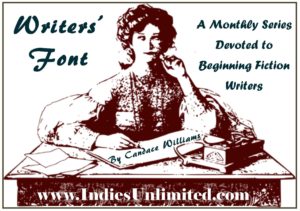 Last month we looked at the most common Points-of-View used in fiction today: First Person, Third-Person Limited, and Third-Person Omniscient. Now let’s explore some pitfalls to avoid in mastering POV.
Last month we looked at the most common Points-of-View used in fiction today: First Person, Third-Person Limited, and Third-Person Omniscient. Now let’s explore some pitfalls to avoid in mastering POV.
Head-Hopping. Switching the viewpoint back and forth between characters in the same scene without a, well, a “heads-up” alert to the reader, is called head-hopping. It’s something to avoid because first, it makes the reader pause in his enjoyment of your story to figure out whose “head” he’s in (whose viewpoint) and second, when a reader is pulled out of a story, even momentarily, it interrupts the flow and unnecessarily weakens the impact of the scene. Example: Continue reading “Writers’ Font: Point of View Confusion”
Like this:
Like Loading...
 In June, we looked at the most common Points-of-View used in fiction today: First Person, Third-Person Limited, and Third-Person Omniscient. In July, we examined some pitfalls to avoid in mastering POV.
In June, we looked at the most common Points-of-View used in fiction today: First Person, Third-Person Limited, and Third-Person Omniscient. In July, we examined some pitfalls to avoid in mastering POV.
 Part 2: How to Query an Agent
Part 2: How to Query an Agent Part 1: How to Find an Agent
Part 1: How to Find an Agent